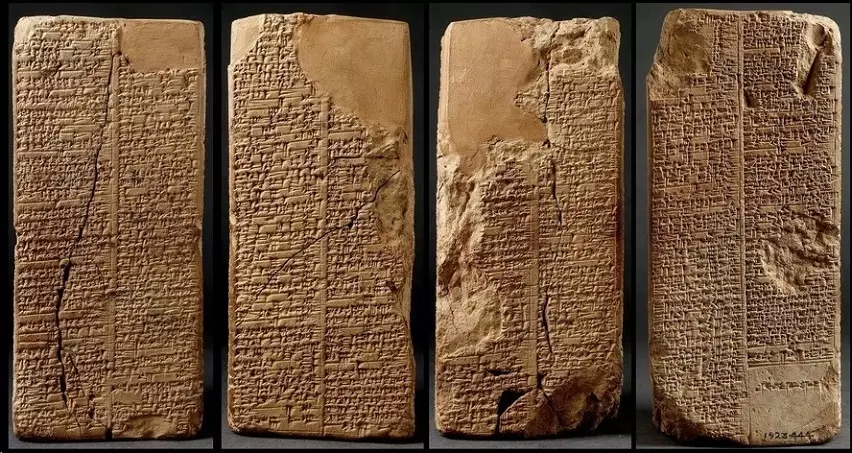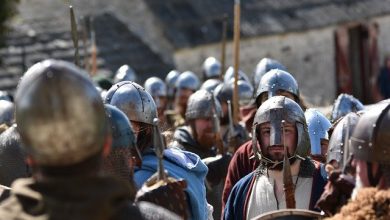First war on Earth: “The dust storm of Sumer”

Since the first evidence of Homo sapiens was discovered on the African plains, how many wars have there been in total? When have we done this before, taken up arms? We fought to the death for supplies and “living space,” and in the process, we eliminated each other. I am afraid that the true answer to this issue is buried much too deeply under the milestones of a thousand-year history that are littered with the bones of the vanquished as well as the bones of those who conquered them. But when exactly did it happen for the very first time? When and where did the first war break out?
In today’s parlance, the phrase “war” refers to a struggle that takes place between political entities via the use of armed activities. At the same time, it is impossible to talk about an armed conflict with the inequality of the parties because if the Upper Kingdom of Egypt invades the territory of modern-day Somalia with an organized army, and there are only a few scattered settlements of herding communities, is this a war? Similarly, if the Lower Kingdom of Egypt invades the territory of modern-day Yemen with an organized army, is this a war? Is this the fate of soldiers if, for example, the first Chinese empire must raise an army in order to subdue peasant uprisings and unify the many provinces under its rule?
We shall have to go into the domain of sand and the gods of antiquity in order to locate the actual spirit of battle. Before Caesar defeated Pompey in the civil war, before the wars of the Greek polis, before the Persian Empire, even before the Babylonian kingdom itself arose at the beginning of the second millennium BC, and before Babylon became Babylon, there was the city of Kadingir, and it was the largest Sumerian metropolis located at the crossroads trade routes.
“A tower that reaches the heavens” is what the word “Kadingir” signifies when translated from its original Sumerian. The phrase “a tower that reaches the heavens” was originally written in ancient Akkadian, and the name “Babylon” is a direct transcription of that phrase. The mighty Akkadian state, which existed before the Babylonian one, had the title of being the most powerful throughout its era. It was the first state in Mesopotamia to be of a new kind, and it was despotic, with strong centralized authority. It served as the foundation for all later governments in the region.
The Akkadian system, in many respects, was the adoption of Sumerian customs. For example, the nomes were led by relatives and nobles who owed their status to the monarch, and the king, upon annexing the regions, appended additional titles to his names, such as Lugal Kisalsi (ruler of the city of Kish) or lugal Urra. And at the helm of the dynasty that was responsible for uniting the provinces of Mesopotamia was the dynasty of Sargon the Ancient, who is considered to be one of the most powerful monarchs in Mesopotamia.
In the year 2316 BC, a common Semite who worked as a gardener in the palace assassinated the local monarch, and then, with the backing of the populace, he grabbed the throne and assumed the name Sharrum-ken, which means “real king.” He thereafter ruled the region, and he initiated the practice of placing the whole Sumerian valley under the authority of a single monarch. However, the history of the people who settled in Sumer began far earlier, about 6,900 years ago…

However, the emergence of civilization as a singular cultural, linguistic, and social agglomeration does not always entail the commencement of hostile interactions between people. Egypt’s civilization and that of the Indus Valley both date back a significant amount of time. But in contrast to them, ancient Sumer was composed of several independent city-states, much like the Greek cities of Athens and Sparta. In each of them, the authority resided either with the Ensi, who served as the cult’s high priest, or with the Lugal monarch. The religious aspect played a very significant role: each city had its own distinctive patron deity, whose whims and preferences the residents sought to appease by behaving in a manner that was consistent with his personality.
Cuneiform writing and the production of clay tablets, the oldest texts of which date back to 3300-3000 BC, are significantly responsible for the preservation of the majority of what is now known to us. The Great List of Sumerian Kings is the most significant document that gives us the ability to rebuild the image of the interaction between the ancient polis in the Sumerian Valley. A massive stone stele that is covered with inscriptions is a one-of-a-kind item in and of itself, and it is believed to be the source of more than one conflict. The interesting thing about it is that it shows the dates of monarchs’ reigns as well as the geographical and dynastic shifts that occurred inside their kingdoms. In point of fact, for the ancient Sumerian rulers, it served as a validation of their claim to the throne, as a pedigree, and often as a justification for war with their neighbors.
There were quite a few cities, including Eridu, Bad Tibira, Larak, Sippar, and Shuruppak. These five towns are among the most ancient in the world, and their histories date back to “before the flood,” as recorded in Sumerian texts.
Up until later ones, like Uruk and Kish, for example. In the year 2900 BC, the city of Uruk had a population of up to 80,000 people, it was covered with thick stone structures, and, according to the stories, it was controlled by the legendary Gilgamesh. This information is provided so that you may grasp the scope of the regulations. The city of Kish, for instance, is well-known due to the fact that it was here that archaeologists discovered the first evidence of the development of Sumerian writing.
The tablet that was discovered in Kish was dated to 3500 BC. Cities frequently engaged in competition with one another; for example, if in the 28th century BC, Kish was the center of the unification of Sumerian tribes, by the 27th century, it had lost this status as a result of a conflict with Uruk, and by the 24th century it was completely destroyed on the order of LugalZagesi (literally “sacred king”).
But the wars of the polis, with their fleeting alliances and never-ending efforts to gain the upper hand, more closely resemble ongoing feudal conflicts. The Sumerian society was unified in many ways: it had a common language, tight commercial relations, dynastic marriages, and shifting alliances; diverse patron gods were integrated into one system of cosmology led by Innana (Ishtar); and it had a single language.
When people from other civilizations arrive at the boundaries, everything shifts and becomes different. Thus comes the answer to the question, when in the annals of human history is it even feasible for there to be the very first war? When there are two states, each of which has its own army. Surprisingly, the influence of nearby neighbors was significant in the process that led to the unity of the Sumerian polis under the Akkadian Empire.
In the third millennium before the common era, a new state known as Elam emerged in what is now the southwestern part of Iran. Sumerian and Akkadian records identify a number of Elamite city-states, including Shushen (also known as Susa), Anshan (also known as Anchan), Adamdun, and many more. These city-states were situated between the mountain rivers Karun and Kerkhe, which spilled into what is now the Persian Gulf lagoon. The people who lived in the Elam polis spoke a language that is no longer understood; its classification as a linguistic group has not even been determined. And the Proto-Elam pictographic writing that has been uncovered in hundreds of manuscripts has not yet been researched or decoded.
Religiously speaking, they were distinct from the Sumerians. First of all, Elam had a matriarchal style of life, which was, of course, mirrored in their religion. The goddess Kiririshe stood at the top of the pantheon, and according to Sumerian records, her name meant “Divine Mother.” These kinds of cults, which place the female divinity of the foremother at the top of the pantheon, have their origins in the Paleolithic period, which occurred a very long time ago. The closeness of the two territories combined with the existing tensions made the confrontation unavoidable.
According to the Great List of Sumerian Kings, King Enmebaragesi of the city of Kish is credited with being the one who initiated the conflict. The combination of the mythical and actual depictions of this monarch creates an intriguing figure, which is partly why his figure is noteworthy. On the one hand, archaeological artefacts provide evidence that they did, in fact, exist. On the other hand, he is referenced in the Gilgamesh epic, and the length of his reign is said to have been 900 years of continuous rule.

In later records kept by the Akkadian Empire, the struggle between Elam and Sumer had placed between the years 2335 and 2154 BC, when King Enmebaragesi of Sumer conquered the ancient city of Susa, which served as the capital of Elam at the time. The deity Zababa, who was often portrayed as an eagle and placed on command staffs’ heads, was considered Kish’s patron saint. This personified the god of battle, who was also known as the “stone breaker.”
And at some point in the future, one of the city gates in Babylon will be given his name. Inshushinak, the deity of justice, is considered to be the patron saint of Susa. You may also see a ziggurat that was constructed in his honor and is situated not too distant from the spot where the city once stood.
Where and when exactly did the war take place? The Vulture Stele is the most significant monument that provides us with the ability to comprehend how the war took place during this time period. It represents King Lagash, who in 2525 BC was responsible for capturing the city of Ummah. It was a dispute between two Sumerian polis governments. Nevertheless, we can see significant elements that are typical of the conflicts that occurred in Mesopotamia.
The six-row phalanxes that the warriors with copper helmets form resemble the phalanxes that were used by the ancient Greeks. Each row has eight individuals. A spear serves as the primary offensive tool for the phalanx. A monarch armed with a bronze axe rides in a chariot that is pulled by four untamed donkeys. Sickle-shaped swords are often associated with depictions of elite soldiers. The burial pits found close to the city of Ur provide evidence of the sophisticated craftsmanship required to make such helmets with lining and garter.
One of the most significant advancements in military technology during the period was the creation of Sumerian war chariots with rough wooden wheels. The ever-present competition over public policy has resulted in remarkable technical progress. The chariots had four wheels, leather upholstery, were very sturdy, moved quickly, and were hefty. Because of this, it needed to bring at least two and no more than four animals to the war with it.
The foundable garters that include metal rings for control are an example of an invention. Later civilizations such as those of Assyria, Hittite, and Egypt will successfully accept these inventions, bring them to perfection, and create the very war chariots that will go down in the military history of the Middle East. These chariots will have a prominent place in the history of the region. The first armor pieces appearing on the characters are cloaks made of metal disks and enormous rectangular shields.
Although there were no specialized siege weapons, there were light wooden ladders and a variety of rams available for use. There is currently no information available on the defensive capabilities of the Suz from that era. It would seem that the army’s technological excellence and the need to maintain constant professional forces to compete with the policies of surrounding states were the deciding factors in the conquest of Elam. At the opportune time, Kish and the other cities in its alliance were able to deploy an army that successfully defeated a neighboring state and annexed a city with a significant population during the same conflict.
Echoes of previous wars may still be heard in this area thousands of years later, whether it is the Iran-Iraq War, the occupation of Kuwait, or even the very name of Israeli tanks – Merkava (“chariot”). The spot on earth where the very first armed battles broke out is still significant to the gods who oversee warfare.




